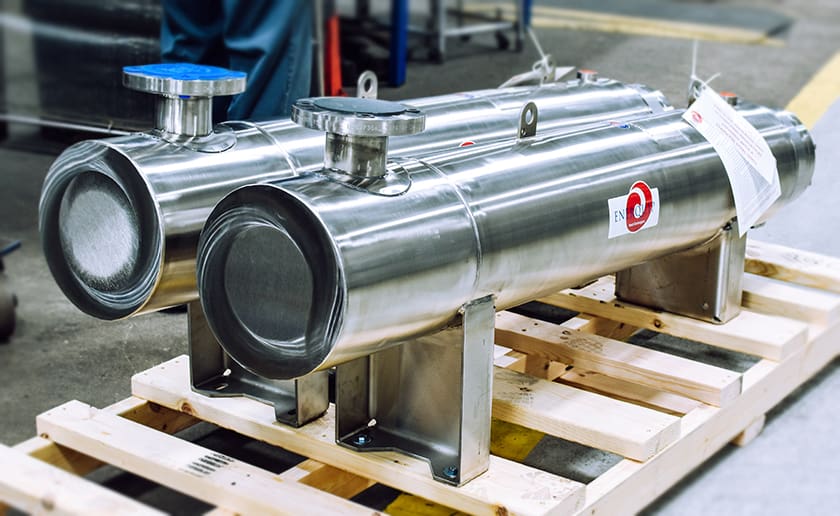
CIP systems are very effective in keeping equipment free of fouling and are regarded highly by 3-A Sanitary Standards
There are some basic priorities every food, beverage, and pharmaceutical manufacturer shares: Make a quality product, minimize downtime and maintain sanitary conditions in the facility.
Careful planning, strategy and expertise are necessary to accomplish these tasks. They also require an effective cleaning strategy that reaches all the little crevices throughout the food manufacturing process and properly sanitizes all surfaces.
One much-favored equipment cleaning strategy throughout the food, beverage, and pharmaceutical industries is the clean-in-place method. CIP systems are very effective in keeping equipment free of fouling and are regarded highly by the 3-A Sanitary Standard.
Components of a CIP system
There are many different configurations and styles for CIP systems, though there are some features the majority of them have in common. These may include:
- Pumps to add the chemical sanitizers.
- Pumps and valves to bring in the supply of water.
- A supply-side heat exchanger.
- A method of recording data (temperature, start/end times, amount of water and sanitizer used). The method can either be electronic or manual.
All CIP systems have a system of one or more tanks: Some have one tank, which allows for a combined rinse and wash cycle. Others have two tanks to separate the rinse and wash processes. Some CIP systems add a third tank to be used for a recovery process, and others have a fourth tank for alkaline, acid or sanitizer storage.
Some CIP systems are one-pass systems that require careful chemical dosing; others are multi-pass systems which necessitate an additional tank to hold alkaline, acid or sanitizer – often the reason a fourth tank is included in the CIP system.
Manufacturers designing CIP systems also have a variety of options for how to distribute the water and cleaners throughout the equipment. They can use spray balls, which are more tailored to processes that don’t require very high water pressure. For those that do need highly pressurized water, rotary spray heads are used more often.
In either case, it’s essential that the entire surface area is reached by the spray method to ensure a total and complete clean. A missed spot resulting from poor design or insufficient components may harbor contaminants and become a serious problem in the long term.
Flow in a CIP system
It’s important to consider what flow rate is really needed when designing a CIP system. One might immediately think the higher the flow rate the lower the risk for inadequately clean equipment. However, erring on the side of higher pressure can also mean higher energy, water and cleaning costs. It’s best to have it just high enough of a flow to be effective, but not overdo it.
If a problem with a CIP system emerges, managers may assume the solution is to increase the flow. However, there are alternative solutions that can improve cleaning processes without a major impact on costs.
The most challenging parts of equipment to clean are dead-ends, crevices and corners, such as the bends in a u-tube shell and tube heat exchanger. In these instances, increased flow is often ineffective, as well as costly. Some different approaches to cleaning challenging parts of the equipment include:
- Pulsating and varying the direction of the flow.
- Ice-pigging, or pushing an ice slushy through the piping from the CIP.
- Effervescence in the water, which creates localized wall-shear stresses.
- Jet cleaning, or directing a high force to a specific area.
Additionally, draining the processing line before engaging the CIP system may also help. This way, when the CIP is turned on and the water fills the lines, it’ll create a moment of harder force than if the water was already in the line.
Documentation of CIP systems
It’s a legal requirement that food manufacturers document their cleaning process, Commercial Food Processing pointed out. Luckily, many CIP systems have automated documentation capabilities. However, just because it happens automatically doesn’t mean it shouldn’t be regularly and frequently monitored, or that manufacturers shouldn’t make adjustments or additions to the documentation process.
Event archiving is also a necessary aspect of having and properly maintaining a CIP system. Event archives include cycle start and end times, wash times and quantities of materials used in the cleaning. In the past, this was done by hand, though manual recording is no longer industry standard, nor does it meet regulatory compliance. Software innovations have been brought to market to address this need as well.
In addition to the typical information recorded by event archivers of the past, software-based event recorders also include data like whether a process was interrupted (and why); whether an operator took additional steps before, during or after the cleaning process; whether a step was repeated or skipped; and whether the operator paused or aborted the cycle before it was completed. The software can compile all the relevant data into reports that can be printed, as well as import it to databases so it can be accessed more conveniently and compared to past reports.
Most importantly, using software-based historians and event recorders makes regulatory compliance easier for manufacturers, and can more accurately identify emerging or existing problems in the CIP system.
If you’re in the market to upgrade your CIP system, consider how a stainless steel shell and tube heat exchanger can help. The knowledgeable engineers at Enerquip know the importance of fabricating exchangers that meet stringent regulations such as 3-A and ASME-BPE. Contact us today or request a quote.
